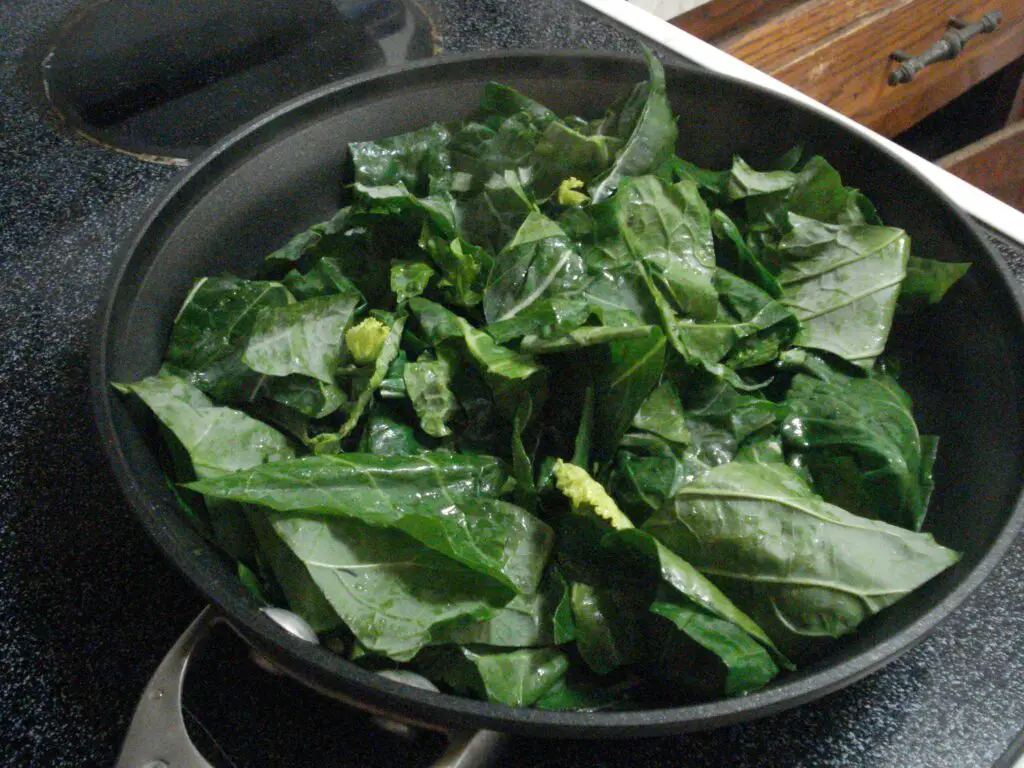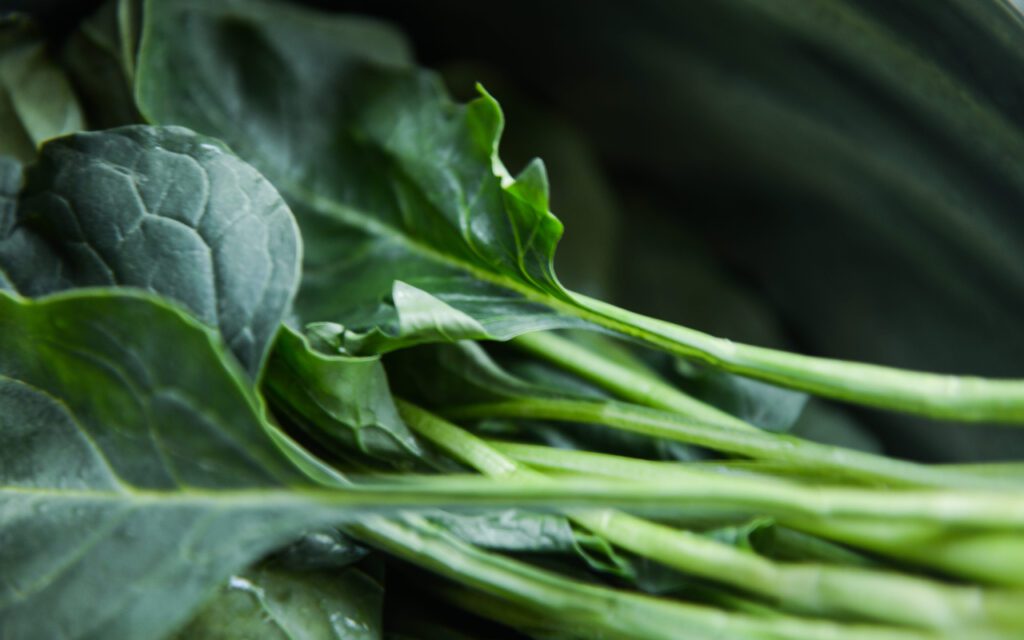As a veterinary nutritionist, I often get asked about the types of human foods that pets can safely consume. One such question that comes up frequently is whether dogs can eat collard greens.
Collard greens are considered to be one of the healthiest vegetables for humans due to their high nutritional value, but it’s important to understand whether they can provide the same benefits to dogs.
In this post, we’ll explore whether dogs can eat collard greens and the potential benefits and risks associated with feeding them to your furry friend.
- Can Dogs Eat Collard Greens?
- How Much Collard Greens Can Dogs Eat?
- How Often Can Dogs Eat Collard Greens
- Health Benefits of Collard Greens To Dogs
- Potential Risks of Feeding Collard Greens To Dogs
- Nutritional Benefits of Collard Greens For Dogs
- Are Dogs Sensitive To Collard Greens?
- How To Prepare Collard Greens For Dogs
- How Fast Will Dogs Digest Collard Greens
- FAQs
- In Conclusion
Can Dogs Eat Collard Greens?

Yes, dogs can eat raw and cooked collard greens (with the stem included) in moderation.
Collard greens are packed with vitamins and nutrients that can offer several potential health benefits to your furry friend.
However, it’s important to understand that dogs have different nutritional requirements than humans, so it is essential to feed them collard greens in the right way.
Collard greens are an excellent source of vitamins A, C, and K, as well as calcium, iron, and fiber, all of which can support your dog’s overall health.
Additionally, they can help reduce inflammation, lower the risk of certain cancers, and improve digestion.
When feeding collard greens to your dog, make sure you steam or boil them before serving. Raw collard greens can be challenging to digest and can potentially lead to digestive issues such as bloating, gas, and diarrhea.
Furthermore, it’s essential to feed your dog collard greens in moderation, as overfeeding can lead to digestive issues.
Overall, collard greens can be a healthy addition to your dog’s diet but always consult with your veterinarian before adding any new human food to your pet’s diet.
See also: 47 Safe Vegetables To Feed Your Dog. Puppy Power!
How Much Collard Greens Can Dogs Eat?

A general rule of thumb is to feed collard greens as an occasional treat or in combination with the dog’s primary diet.
Dogs can eat 10% of their daily food intake as fruits and vegetables, so it’s important to keep track of the number of collard greens you feed your dog. The amount largely depends on the size and weight of the dog.
As a guide, for small dogs, you can provide half a cup of collard greens, while for larger dogs, you can give up to one cup of collard greens per day.
Remember, it’s always a good idea to introduce any new food to your dog’s diet gradually to avoid digestive issues.
Collard Greens Feeding Chart According To Size
| Food | Size | Portion |
|---|---|---|
| Collard Greens | Toy dogs | 1 leaf |
| Collard Greens | Small dogs | 1 – 2 leaves |
| Collard Greens | Medium dogs | 1 – 3 leaves |
| Collard Greens | Large Dogs | up to 4 leaves |
Collard Greens Feeding Chart According To Age
| Food | Age | Portion |
|---|---|---|
| Collard Greens | 0 – 6 months | Don’t feed |
| Collard Greens | 6 – 12 months | 1 leaf |
| Collard Greens | 12 – 24 months | 1 – 3 leaves |
| Collard Greens | 24+ months | up to 4 leaves |
How Often Can Dogs Eat Collard Greens
A good rule of thumb is to feed dogs collard greens once or twice a week as part of a balanced diet. Overfeeding collard greens can lead to digestive issues such as gas, bloating, or diarrhea, so it’s crucial to feed collard greens in moderation.
If your dog has any underlying medical conditions, such as kidney disease or hypothyroidism, it’s best to consult your veterinarian before adding collard greens or any new food to their diet.
Dogs with specific medical needs may require more or fewer green leafy vegetables, and your veterinarian can advise you on the right amount for your dog.
Overall, collard greens are a healthy addition to your dog’s diet if fed in moderation, combined with their primary diet, and considering their individual medical and nutritional requirements.
Health Benefits of Collard Greens To Dogs
- Rich in Nutrients. Collard greens contain vitamins and minerals like vitamins A, C, and K, calcium, iron, and fiber, all of which are essential for your dog’s overall health. These nutrients can help improve your dog’s bone health, vision, immune function, and digestion.
- Anti-inflammatory Properties. Collard greens contain anti-inflammatory properties that can help reduce inflammation in your dog’s body. This can be especially beneficial for dogs with joint problems or other inflammatory conditions.
- Low in Calories. Collard greens are low in calories, which makes them an excellent addition to your dog’s diet, particularly for those who need to lose weight. They offer a natural source of nutrition without adding too many extra calories.
- Boosts Cancer Prevention. Studies have found that collard greens contain compounds that can help reduce the risk of certain cancers in dogs. These compounds can help prevent the formation and growth of cancer cells.
- Promotes Digestive Health. Collard greens are rich in fiber, which can aid in your dog’s digestion and prevent constipation. The fiber in collard greens can also help regulate blood sugar levels and reduce the risk of diabetes in dogs.
- Promotes Hydration. Collard greens have a high water content, which can help keep your dog hydrated. Adequate hydration is essential to maintain optimal kidney function and to help prevent urinary tract infections.
Potential Risks of Feeding Collard Greens To Dogs
- Digestive Issues. Raw collard greens are difficult for dogs to digest and can lead to digestive issues such as gas, bloating, and diarrhea. It’s important to cook collard greens before feeding them to your dog.
- Oxalate Content. Collard greens contain oxalates, which can bind to calcium and cause problems such as kidney stones. Dogs with a history of calcium oxalate stones should avoid collard greens due to their high oxalate content.
- Pesticide Residue. Collard greens are one of the crops most sprayed with pesticides. Feeding your dog non-organic collard greens may expose them to harmful chemicals, which can lead to toxicity or other unwanted side effects.
- High Sodium Content. Collard greens contain naturally occurring sodium. While small amounts are okay, it’s crucial not to overfeed your dog with collard greens, especially if they are on a low-sodium diet.
- Interference with Medication. Collard greens contain vitamin K, which can interfere with some medications, particularly blood thinners. If your dog is on medication, it is essential to discuss any dietary changes with your veterinarian before feeding them collard greens.
Nutritional Benefits of Collard Greens For Dogs
| Collard Greens Nutrition Facts per 100 grams | % DV * |
|---|---|
| Calories | 32 |
| Total Fat | 0.6 g |
| Cholesterol | 0 mg |
| Sugar | 0.5 g |
| Glycemic Index | 55 |
| Sodium | 94 mg |
| Carbs | 5 g |
| Protein | 3 g |
| Vitamin D | 0% |
| Calcium | 23% |
| Iron | 2% |
| Potassium | 213 mg |
Are Dogs Sensitive To Collard Greens?
Dogs are not typically sensitive to collard greens. However, some dogs may experience adverse reactions to them, particularly if they have underlying digestive or medical issues.
The symptoms of sensitivity to collard greens can vary depending on the severity of the reaction, but some common symptoms may include:
- Vomiting
- Diarrhea
- Gas and bloating
- Abdominal pain
- Loss of appetite
- Lethargy
- Itchy skin or rashes
If your dog experiences any of these symptoms after eating collard greens, it’s crucial to stop feeding them immediately and contact your veterinarian.
They can help diagnose the cause of the symptoms and provide the appropriate treatment.
How To Prepare Collard Greens For Dogs
Steamed Collard Greens
Steaming the collard greens is one of the healthiest ways to prepare them for your dog because it retains most of the nutrients. Start by thoroughly washing and cutting the collard greens into small pieces. Add the pieces to a steamer basket and steam until they are bright green and tender. Allow them to cool before serving your dog.
Boiled Collard Greens
Boiling collard greens is another option for preparing them for your dog. Wash and chop the collard greens into small pieces, place them in a pot of boiling water, and boil for about 10-15 minutes or until tender. Then remove from the pot and set aside to cool before serving.
Collard Greens and Meat Broth
If you want to give your dog an extra treat, cook collard greens with their favorite meat broth. Add chopped collard greens to a pot of meat broth and simmer until the greens are tender. The meat broth can help mask the bitter taste of the collard greens, making them more appealing to your dog.
How Fast Will Dogs Digest Collard Greens
The digestion rate of collard greens in dogs can vary depending on several factors such as the dog’s size, age, and digestive health.
However, if cooked and chopped into small pieces, it should take between 4 to 6 hours for a dog to digest collard greens.
It’s essential to note that collard greens are high in fiber, which can help improve your dog’s digestion and prevent constipation.
However, overfeeding collard greens or adding them too quickly to your dog’s diet can lead to digestive issues such as gas, bloating, and loose stool.
To prevent digestive issues, it’s best to introduce collard greens gradually and in small amounts.
Start by adding a small piece of cooked collard greens to your dog’s meal and slowly increase the portion over time.
Additionally, always monitor your dog’s reaction to collard greens and adjust their diet accordingly.
FAQs
Can dogs eat collard green stems?
Yes! In fact, collard green stems are a great source of dietary fiber and vitamin K for dogs. They can help to improve digestion and provide essential vitamins and minerals. However, it is important to feed them in moderation as too much could cause digestive upset or even harm your pup.
In Conclusion
In conclusion, collard greens can be a healthy treat for dogs when fed in moderation and prepared correctly.
They contain high levels of vitamins and minerals that can offer several potential health benefits, but it’s essential to introduce them to your dog’s diet gradually and in small amounts to prevent any adverse reactions.
Furthermore, it’s crucial to cook the collard greens before feeding since raw collard greens are hard for dogs to digest and can cause digestive issues. It’s also important to avoid feeding a lot of collard greens to dogs, as this can cause digestive problems.
If your dog has a particular medical condition or takes specific medication, it’s always best to consult with your veterinarian before adding collard greens or any new food to their diet.
Overall, collard greens can be a nutritious and delicious addition to your dog’s diet, providing valuable vitamins and minerals and supporting your dog’s optimal health.





Leave a Reply